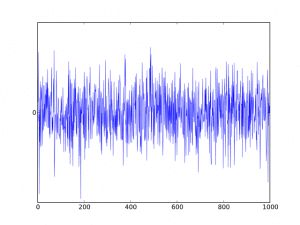By Barry Keate
Barry Keate, has lived with tinnitus over 40 years and has published 150+ research articles on numerous aspects of tinnitus. He is an expert on the condition and a well-known advocate for those with tinnitus.
White noise therapy has been used in a variety of ways to provide tinnitus relief. It masks the sounds caused by tinnitus so that these sounds are not as noticeable. Though some have utilized white noise as a tinnitus remedy, a new study shows it doesn’t help in the long-term and can actually damage the auditory system in ways that can worsen tinnitus and prevent habituation and recovery.

White noise is a type of random, unstructured noise that is sometimes created by broad-band static and has equal intensity at all frequencies. It is used in sound-generating machines, smart phone apps, tinnitus-masking hearing aids, and other products that are advertised to be effective providers of tinnitus relief.
Listening to ambient white noise is included among a small handful of tinnitus remedy options in a clinical practice guideline published by the American Academy of Otolaryngology, the professional academy of ENT physicians. However, a 2018 study from researchers in San Francisco states that, in the long term, white noise undermines the functional and structural integrity of the central auditory system in the brain and worsens tinnitus over time. (1)
Brain Plasticity and Tinnitus
The central thesis of the study is that the brain is capable of continuous, large scale change over time. Neurons become wired together depending on behavioral, environmental, and emotional input. Essentially, the brain can re-wire itself and strengthen or weaken its structures to conform to new inputs.
Brain plasticity, also called neuroplasticity, is what allows us to learn, develop language skills, and grow into the diverse human beings we are with individual likes, dislikes, skills, and emotions. Neuroplasticity occurs in all people of all ages, but is particularly pronounced in one’s youth, when the brain is growing and developing rapidly.
There are a number of different neurotransmitters involved in neuronal signaling. The workhorse transmitters in the cochlea and auditory nerve are the inhibitory (or calming) neurotransmitter, GABA, and the excitatory neurotransmitter, glutamate. These two chemicals must be kept in balance for healthy hearing and cognition. Most tinnitus cases are created due to hearing loss. When this happens, inhibitory neurotransmitter release is substantially reduced and excitatory neurotransmitters dominate.
When hearing cells in the cochlea are damaged, they release excessive amounts of glutamate. This overwhelms the inhibitory GABA and leads to a hyperexcited state where the neurons keep firing until they eventually become depleted and die. This hyperexcitability is heard by the auditory cortex as tinnitus. Over time this hyperexcitability re-wires the auditory cortex until it becomes a permanent sound, even if the initial input of damaging noise is no longer present.
For more on excitatory neurotransmitters and how Arches Tinnitus Formula helps reverse this, see our article, How Noise Causes Hearing Loss and Tinnitus.
Low Level Sound That is Used as a Tinnitus Remedy Also Causes Tinnitus
Both loud, damaging sounds and white noise exposure can lead to hearing loss and tinnitus. One of the most surprising and disturbing revelations in this paper is the low sound level at which this damage can occur.
A rapidly growing body of evidence has now established that long-term exposure to nontraumatic, low level noise is capable of causing changes in the auditory system that cause widespread hyperexcitation and leads to tinnitus. According to this evidence, a person’s hearing thresholds may not change, and they will not exhibit hearing loss as determined by an audiogram.
These changes have been observed following exposure to noise levels in the 60 to 70 dB range, which is a typical range produced by commercially available noise generators. This level of noise is considered “safe” by the US Occupational Safety and Health Administration (OSHA). Auditory changes have been documented as developing in both youth and adult subjects following exposures of as little as a couple of months and persisting for several weeks or months after noise exposure is stopped.

If the noise exposure is continued daily, the changes become permanent and are hard-wired into the auditory cortex. This may explain why many people experience tinnitus despite having no obvious medical cause or no perceptible hearing loss.
The available evidence suggests that sound therapies implementing unstructured white noise may produce a temporary treatment for tinnitus by masking tinnitus sound but, in the long run, are adding fuel to the fire and actually worsening it.
Positive Sound Therapies for Tinnitus Relief
Researchers suggest that there are other ways of presenting structured sound to the brain that will help restore the functional integrity of the auditory system. The most straightforward way to do this is to simply replace the masking stimulus with a structured acoustic signal, such as symphonic music, which activates the entire range of hearing and reduces hyperexcitability.
There are promising results using music that has been filtered to match an individual patient’s tinnitus frequency. Music that has been “notched” to remove the frequencies close to the tinnitus have been shown to reduce tinnitus-related hyperexcitability. This offers an effective treatment for tinnitus.
Similarly, acoustic neuromodulation programs, such as specially programmed hearing aids, randomly present brief tones both above and below the pitch of the tinnitus that helps reduce neuronal excitation and reduce tinnitus loudness and annoyance.
Those using structured sound therapy for tinnitus relief may incur extra costs associated with this tinnitus remedy, as it must be personalized for each individual’s tinnitus symptoms.
For those who cannot afford such programs, clinicians may recommend exposure to unmodified music.
These sound therapies for the treatment of tinnitus should be combined with Arches Tinnitus Formula. This product will strengthen their effectiveness, help reduce hyperexcitation, and reduce the loudness and annoyance of tinnitus.
References:
1 – Attarha M, Bigelow J, Merzenich M. Unintended Consequences of White Noise Therapy for Tinnitus – Otolaryngology’s Cobra Effect. JAMA Otolaryngol Head Neck Surg. 2018;144(10):938-943.
